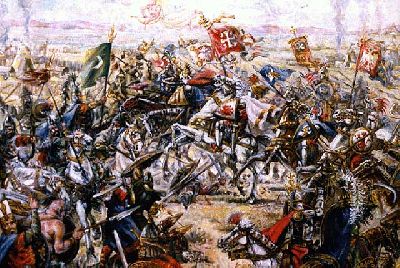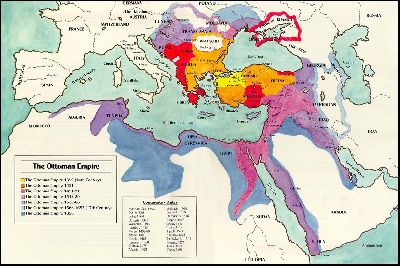Baltimore IMC : http://www.baltimoreimc.org
News :: Europe : History : International Relations
LEGEND OR NOT
"Choosing the heavenly kingdom over the earthly one, he and his army went to victorious martyrdom.” – about Tsar Lazar, words of Life by Fr. Daniel M. Rogich - Service translated by the St. Herman of Alaska Brotherhood from their book “GREAT-MARTYR TSAR LAZAR of SERBIA His Life and Service (ISBN 0-938635-80-8)
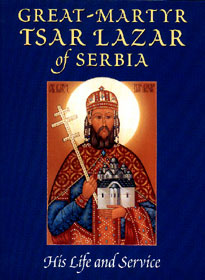
Title page of the book quoted in the opening
Legend or not
“Choosing the heavenly kingdom over the earthly one, he and his army went to victorious martyrdom.” – about Tsar Lazar, words of Life by Fr. Daniel M. Rogich - Service translated by the St. Herman of Alaska Brotherhood from their book “GREAT-MARTYR TSAR LAZAR of SERBIA His Life and Service (ISBN 0-938635-80-8)
Kosovo’s legacy remains in the hands on non-inhabitants of that land. The forces who appointed themselves as the key decision makers are far removed from anything Kosovan. To understand this we shall look at the key moment of Kosovo’s history, June 28th, 1389. There have been suggestions that Kosovo is to Serbians what Jerusalem is to the Jews. I think that’s an understatement.
HISTORICAL BACKDROP: From about 1299 The Ottoman empire was on a steady increase. Deservedly so. They employed the old Roman method of granting partial freedoms while appointing their veziers to rule larger domains. Under the veziers (viziers) you would commonly have a local bey (beg) or pasha, all being under the rule of a Sultan – the top dog in Ottoman language. Conversion to Islam – although the Ottomans were Turks rather than Arabs who first proliferated Islam in Asia Minor, assured the natives more benefits from the rulers. The culmination (and the end of Ottoman rule) took place at the gates of Vienna which was actually a whole series of attacks and counter attacks. To bring this Ottoman business to its logical end let’s just conclude that the end developed along the following lines: The battle(s) took place in the night between 11 September 1683 and 12 September 1683, finishing about at 5 p.m., and was the first large-scale battle of the Habsburg-Ottoman Wars, yet with the most far-reaching consequences. The battle pitted a 30,000-man Polish relief army under Jan III Sobieski King of the Polish-Lithuanian Commonwealth, who was made Commander in Chief, and Habsburg army of about 40,000 troops and their allies, led by Charles V, Duke of Lorraine, against the Ottoman army, commanded by Grand Vizier Merzifonlu Kara Mustafa Pasha, which numbered approximately 138,000 men, although a large number of them played no part in the battle. The siege itself began in 14 July 1683, and the decisive battle took place on 12 September, when the Muslim armies were defeated at the Gates of Vienna.
The battle marked the turning point in the 300-year struggle between the forces of the Central European kingdoms, and the Ottoman Empire. Over the sixteen years following the battle, the Habsburgs of Austria, and their allies gradually occupied and dominated southern Hungary and Transylvania, which had been largely cleared by the Turkish forces. It is said that the croissant (wrongly thought of as French pastry product) was first baked in Vienna in the shape of the Crescent that had just been defeated – so much for baker’s contribution. The ending days of Ottoman rule gradually freed other occupied Christians like Serbians (about 1814), Macedonians (about 1912), Greeks (about 1913 to 1915), which now ended the Ottoman presence on European soil with the small exception of Istanbul (a Greek town known as Constintinopolis) as it was founded by one of the last Byzantine Emperors Constantine. That part of European soil is the only basis for the Turkish efforts to be admitted into the EU – today. This is how a small piece of land from 600 years ago begins to play a major role in today’s politics.
The story of Ottoman conquest of Serbia (beginning with the battle of Kosovo) is no less complicated – it is only more complex and has issues or greater importance that are not even close to being resolved after those same 600 years have passed.
In short, a valiant Serbian King (tsar) Lazar was warned by real life spies and mythical premonitions both, that the vastness of the Turkish forces would ensure his certain defeat. There was not one valid military reason to engage in the battle of Kosovo on that June 28th, 1389, yet he went ahead. How and why are the two most vital questions. His (tsar Lazar’s) smaller army was composed of the local noblemen who were all sworn to defend their native land and the last vestiges of Christianity as they were the first generation of Christians after the split of the Roman empire into the Western Roman (today’s Roman Catholic) and Eastern Roman (that day’s Byzantium). Their own views were summed up in the oath on the eve of the battle, where each was sworn with the words: “For the honorable Cross and golden freedom!”, followed by the famous words of St. Sava of Serbia, “Give up everything for Christ, but Christ for nothing!” . It is also vital to know that tsar Lazar was schooled in Prilep during the rule of tsar Dusan where the Kingdom of Serbians and Greeks (as it was called) stretched from the Bosphorus to the gates of Vienna and Budapest in the North/West and Black sea to the East. Map enclosed. As Christianity was in its infancy (while separated from the Roman Catholicism) the Eastern Orthodoxy took a role of the most vital part of any human’s life on Earth. There is every reason to believe that Tsar Lazar wisely and purposely chose his own death and death of all his troops – as they were badly defeated on that terrible day – only so that his spirit would live forever. This is not all there is about that fateful day. There are stories intertwined with legend, wrapped in mythology, boxed inside of wishful thinking, related by sheer desire, retold by foolish pride and re-invented over and over – that I shall refrain from elaborating about. The one story which has most definitely been confirmed puts a shade of plagiarism on Florence Nightingale (1820-1910) a pioneer of modern nursing from England who has portrayed the generosity and kindness of an unknown Serbian woman, only known as Kosovka devojka (the girl from Kosovo). If we go back in time (not too far back) only to the year 1910 – we can easily conclude that Tsar Lazar’s sacrifice was a wise decision. At that time the last of the Serbians (in today’s Macedonia) were freed from the Ottoman 500 years (in most Serbia) and 600 years (in most Greece) occupation, while they retained their Christianity, language, costumes, cooking, religious relics, resisted the forced conversion to Islam and most of those uncommon accomplishments were due to the Heavenly direction that Tsar Lazar chose centuries before where his Earthly sacrifice was worth the salvation of a nation (Serbians). Who in their right mind would ever tell Serbians that Kosovo is NOT rightfully theirs? Only other Muslims (like today’s ever expanding Albanians), or some other shady criminal characters (not too unlike our most recent ex-president Bill Clinton). American history is not that long and it is fairly hard to find adequate comparisons but the Alamo comes to mind real easy. It is not only once that the Americans fought for what was to be the benefit of others (or future generations), like in Normandy, France; like on Iwo Jima in the Pacific, like General Patton’s suicidal advances in both North Africa and Northern France – all those battles have been fought for the prime benefit of others and in that fact lay the common thread between Serbians and many true Americans. For Clinton to have ordered bombing of Serbians on behest of KLA (so called Kosovo Liberation Army), which was found to have had close ties with Osama in subsequent times – was one of the biggest mistakes any American president has ever made.
This is how history meanders its way into our daily lives, without us even noticing much about it.
Iliya Pavlovich
“Choosing the heavenly kingdom over the earthly one, he and his army went to victorious martyrdom.” – about Tsar Lazar, words of Life by Fr. Daniel M. Rogich - Service translated by the St. Herman of Alaska Brotherhood from their book “GREAT-MARTYR TSAR LAZAR of SERBIA His Life and Service (ISBN 0-938635-80-8)
Kosovo’s legacy remains in the hands on non-inhabitants of that land. The forces who appointed themselves as the key decision makers are far removed from anything Kosovan. To understand this we shall look at the key moment of Kosovo’s history, June 28th, 1389. There have been suggestions that Kosovo is to Serbians what Jerusalem is to the Jews. I think that’s an understatement.
HISTORICAL BACKDROP: From about 1299 The Ottoman empire was on a steady increase. Deservedly so. They employed the old Roman method of granting partial freedoms while appointing their veziers to rule larger domains. Under the veziers (viziers) you would commonly have a local bey (beg) or pasha, all being under the rule of a Sultan – the top dog in Ottoman language. Conversion to Islam – although the Ottomans were Turks rather than Arabs who first proliferated Islam in Asia Minor, assured the natives more benefits from the rulers. The culmination (and the end of Ottoman rule) took place at the gates of Vienna which was actually a whole series of attacks and counter attacks. To bring this Ottoman business to its logical end let’s just conclude that the end developed along the following lines: The battle(s) took place in the night between 11 September 1683 and 12 September 1683, finishing about at 5 p.m., and was the first large-scale battle of the Habsburg-Ottoman Wars, yet with the most far-reaching consequences. The battle pitted a 30,000-man Polish relief army under Jan III Sobieski King of the Polish-Lithuanian Commonwealth, who was made Commander in Chief, and Habsburg army of about 40,000 troops and their allies, led by Charles V, Duke of Lorraine, against the Ottoman army, commanded by Grand Vizier Merzifonlu Kara Mustafa Pasha, which numbered approximately 138,000 men, although a large number of them played no part in the battle. The siege itself began in 14 July 1683, and the decisive battle took place on 12 September, when the Muslim armies were defeated at the Gates of Vienna.
The battle marked the turning point in the 300-year struggle between the forces of the Central European kingdoms, and the Ottoman Empire. Over the sixteen years following the battle, the Habsburgs of Austria, and their allies gradually occupied and dominated southern Hungary and Transylvania, which had been largely cleared by the Turkish forces. It is said that the croissant (wrongly thought of as French pastry product) was first baked in Vienna in the shape of the Crescent that had just been defeated – so much for baker’s contribution. The ending days of Ottoman rule gradually freed other occupied Christians like Serbians (about 1814), Macedonians (about 1912), Greeks (about 1913 to 1915), which now ended the Ottoman presence on European soil with the small exception of Istanbul (a Greek town known as Constintinopolis) as it was founded by one of the last Byzantine Emperors Constantine. That part of European soil is the only basis for the Turkish efforts to be admitted into the EU – today. This is how a small piece of land from 600 years ago begins to play a major role in today’s politics.
The story of Ottoman conquest of Serbia (beginning with the battle of Kosovo) is no less complicated – it is only more complex and has issues or greater importance that are not even close to being resolved after those same 600 years have passed.
In short, a valiant Serbian King (tsar) Lazar was warned by real life spies and mythical premonitions both, that the vastness of the Turkish forces would ensure his certain defeat. There was not one valid military reason to engage in the battle of Kosovo on that June 28th, 1389, yet he went ahead. How and why are the two most vital questions. His (tsar Lazar’s) smaller army was composed of the local noblemen who were all sworn to defend their native land and the last vestiges of Christianity as they were the first generation of Christians after the split of the Roman empire into the Western Roman (today’s Roman Catholic) and Eastern Roman (that day’s Byzantium). Their own views were summed up in the oath on the eve of the battle, where each was sworn with the words: “For the honorable Cross and golden freedom!”, followed by the famous words of St. Sava of Serbia, “Give up everything for Christ, but Christ for nothing!” . It is also vital to know that tsar Lazar was schooled in Prilep during the rule of tsar Dusan where the Kingdom of Serbians and Greeks (as it was called) stretched from the Bosphorus to the gates of Vienna and Budapest in the North/West and Black sea to the East. Map enclosed. As Christianity was in its infancy (while separated from the Roman Catholicism) the Eastern Orthodoxy took a role of the most vital part of any human’s life on Earth. There is every reason to believe that Tsar Lazar wisely and purposely chose his own death and death of all his troops – as they were badly defeated on that terrible day – only so that his spirit would live forever. This is not all there is about that fateful day. There are stories intertwined with legend, wrapped in mythology, boxed inside of wishful thinking, related by sheer desire, retold by foolish pride and re-invented over and over – that I shall refrain from elaborating about. The one story which has most definitely been confirmed puts a shade of plagiarism on Florence Nightingale (1820-1910) a pioneer of modern nursing from England who has portrayed the generosity and kindness of an unknown Serbian woman, only known as Kosovka devojka (the girl from Kosovo). If we go back in time (not too far back) only to the year 1910 – we can easily conclude that Tsar Lazar’s sacrifice was a wise decision. At that time the last of the Serbians (in today’s Macedonia) were freed from the Ottoman 500 years (in most Serbia) and 600 years (in most Greece) occupation, while they retained their Christianity, language, costumes, cooking, religious relics, resisted the forced conversion to Islam and most of those uncommon accomplishments were due to the Heavenly direction that Tsar Lazar chose centuries before where his Earthly sacrifice was worth the salvation of a nation (Serbians). Who in their right mind would ever tell Serbians that Kosovo is NOT rightfully theirs? Only other Muslims (like today’s ever expanding Albanians), or some other shady criminal characters (not too unlike our most recent ex-president Bill Clinton). American history is not that long and it is fairly hard to find adequate comparisons but the Alamo comes to mind real easy. It is not only once that the Americans fought for what was to be the benefit of others (or future generations), like in Normandy, France; like on Iwo Jima in the Pacific, like General Patton’s suicidal advances in both North Africa and Northern France – all those battles have been fought for the prime benefit of others and in that fact lay the common thread between Serbians and many true Americans. For Clinton to have ordered bombing of Serbians on behest of KLA (so called Kosovo Liberation Army), which was found to have had close ties with Osama in subsequent times – was one of the biggest mistakes any American president has ever made.
This is how history meanders its way into our daily lives, without us even noticing much about it.
Iliya Pavlovich
Click on image for a larger version

Byzantine Empire as it looked in the time of Lazar's childhood under Tsar Dusan
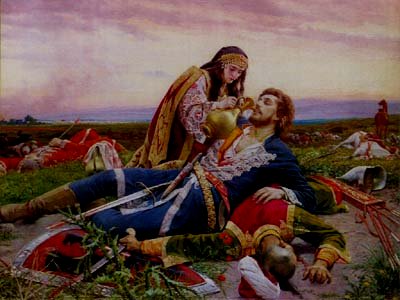
Kosovka devojka (500 years prior to Florence Nightingale)
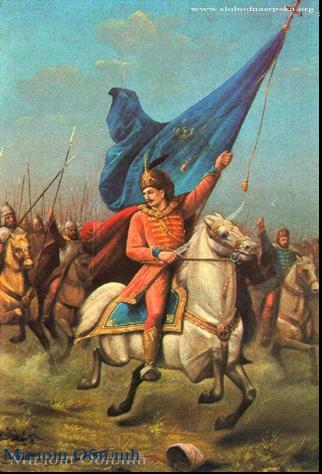
Image of Milos Obilic who swore before his king (tsar Lazar) and his Christian God - that he will kill the leader of the Turks - Sultan Murad - Milos did it at the cost of his own life.
Views
Information
Search
This site made manifest by dadaIMC software

 Copyright by the author. All rights reserved.
Copyright by the author. All rights reserved.
